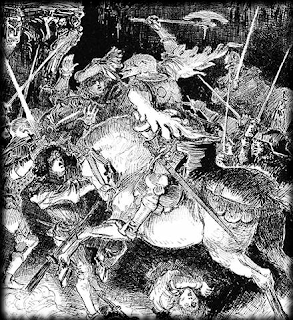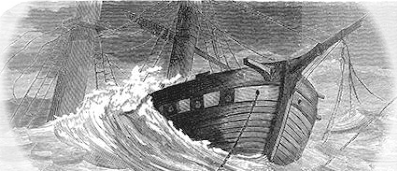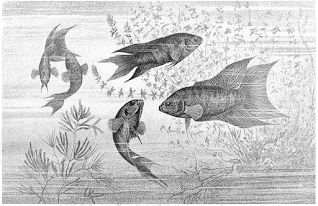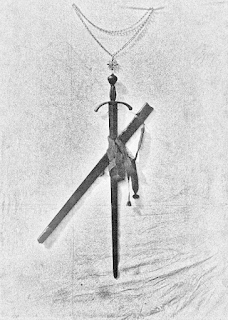The bay, my lad, is a perilous destination for a sailing man – at least, one
who hasn’t seen his way about the shoals before. It seems deep enough, aye,
but throughout – even to the very center – reefs and rocks jut up from the
bottom: waiting to snag your keel and drag the boards right out from under
your bottom. Happened to the Earl’s own son, you know – his two-decker: struck
a crag unseen from the surface, snapped it clean in half! The aft of her
slipping beneath the waves and hanging vertical against the rock!
See now, the captain never did wash ashore… and the crew said they
abandoned ship with naught but the shirts on their backs. A betting man – a
brave man – might be curious to find out if the Earl’s gold was still
onboard along with her dead...

|
Scale: 10 ft.
Click
HERE
for a PDF version of this adventure!
|
Suitable for 4th or 5th level.
| • |

|
A little keyhole icon in a door means the door is locked. |
| • |

|
A little "S" through a door means the door is secret. |
| • |

|
The other icon on a door - which is supposed to look like a muscly arm -
indicates a door is stuck and must be forced open.
|
A Note on Verticality
The boat, having struck a reef, has split in half; the bow – labeled Topside –
is wedged in the coral, comfortably sitting safely at a horizontal plane;
however the stern – labeled Down Beneath – is hanging by a thread: dangling
over the precipice into deeper waters. Thus, all
of the Down Beneath map is under water and should be read with the notion
that “east” (or, left) is actually up: while “west” (or, right) is down – deeper into the water.
Ceilings on the boat are 8 foot.
Wandering Monsters
When a wandering monster is encountered, roll 2d6 on the table below,
consulting the column appropriate to the party’s location to determine the
monster type encountered.
| Roll |
Topside |
Down Beneath |
2
|
Draco (B38)
|
Hydra (X34)
|
3
|
Buccaneer (B35)
|
Mermen (X36)
|
4
|
Sea Snake (B42)
|
Giant Leech (X34)
|
5
|
Crocodile (X29)
|
Mako Shark (X39)
|
6
|
Fresh Water Termite (X40)
|
Giant Piranha (X31)
|
7
|
Giant Crab (X29)
|
Giant Crab (X29)
|
8
|
Flying Insect Swarm (B37)
|
Bull Shark (X39)
|
9
|
Harpy (B36)
|
Sea Snake (B42)
|
| 10 |
Salt Water Termite (X40)
|
Giant Rockfish (X31)
|
| 11 |
Buccaneer (B35)
|
Nixie (X36)
|
| 12 |
Large Crocodile (X29)
|
Hydra (X34)
|
Topside
Super-Level
1 - Upper Forecastle
On the south-east side, arrow slits adorn the wall; on the north east, a hole
the size of a man and a half. Two Harpies (B36) have taken up residence in the
space – which is filled with their nesting.
Main Level
1 - Serpent Watch
Barrels and crates are still battened down in the niches of the outbuilding on
the east side. Four Sea Snakes (B42) bask in the sunlight here. Embedded in
the wall of the eastern enclosure, facing to the bow, is a circular wooden
scarab. If broken open, inside is hidden a Scarab of Protection (X50).
Most of these are empty, some are filled with long-soured water or grog, but
one crate to the south contains silver bullion – 1,200 gp worth – weighing 120
lb. Against the bow is sprawled a mostly-decayed and gull-pecked skeleton,
still in its clothing. It lies atop a lockbox containing 200 gp.
2 - Lower Forecastle
A colossal paper wasp nest has been constructed, spanning the gap between the
stairs up and the forward mast. If disturbed, an Insect Swarm, Flying (B37)
with 4 hit dice will emerge.
3 - Deck Remaining
A wooden lattice covering the opening to below-decks has collapsed, having
been broken in half. Three Fresh Water Termite (X40) are not helping the
matter, slowly working to pulp what support remains.
Sub-Level
1 - Upper Hold
Crates and barrels loaded primarily with foodstuffs, long spoiled or dried up,
are tethered to the walls and floor. A Giant Crab (X29) is foraging and a
ladder tall enough to reach the deck above lies precariously balanced on the
edge to the east.
2 - Officers' Cabin
Bunk beds suitable for officers – four of them – align to the north and west
walls. Linen mattresses, apparently proofed against liquid, remain in three of
them – two west, one north.
A line has been stretched under the lower bunk on the west, such that if one
sits or lies upon it, the line will snap: tearing a hole in the mattress and
releasing a choking powder. Any character in the room when the powder is
released must Save vs Death.
3 - Crew Quarters
Hammocks appropriate for a crew hang along the walls of the space along crates
and a card table near the west wall adjoining room 2. A set of dice sits on
the card table. The dice are cursed. They will roll well whenever no one is
watching, but will cause the bearer to lose any game of chance in which they
partake.
Under a loose board beneath the card table can be found a purse containing 600
gp.
Down Beneath
Super-Level
1 - Helm
The rear mast has broken off, leaving a jagged stump. A helm in the rear
attaches to a thick wooden mount. This helm is precariously attached – and
extremely dense. A character which is behind it and interacts with it has a
chance to dislodge it and must Save vs Paralysis or be caught under it as it
careens downwards into the deeps.
Main Level
1 - Sunken Quarterdeck
Circling in the shallows and sniffing around the stairwells to the bridge are
4 Mako Sharks (X39).
2 - Aftcastle Foyer
Weapon racks along the north and south walls hold long-rusted pole arms. A
heavy table has fallen and is propped against the rear mast; stools are piled
on the east wall.
Small fish take refuge in dead plants in the nooks to the
north and south.
3 - Captain's Office
A table with what appears to be a map stands on the floor as though it is
still upright rather than at a right angle tilt. The map is magically
protected – if a character attempts to read it or attempts to remove it, it
will stiffen, shatter, and explode in a lateral plane. All characters in room
3 are targeted by a single THAC0 18 attack, dealing 1d6 damage on hit: the
trap has a +4 bonus to hit the reader/purloiner only.
4 - Captain's Cabin
A luxurious bed is propped against the east wall. On the west wall hangs a
suit of bronze armor and spear – around the neck of the armor is an emerald
amulet (900 gp value). In the south west corner, a locked chest is bolted to
the floor – it contains 3,000 silver and 200 gold pieces.
5 - Captain's Closet
Two Giant Crab (X29) feed on a bloated corpse – oblivious to knowing they've
accidentally locked themselves in. There is a 2-in-6 chance that one will be
on the door when a party member opens it: causing the crab to fall through
into room 4.
Sub-Level
1 - Sunken Hold
A
school of four Giant Piranha (X31) circle ominously, concealed from
the Mako outside.
2 - Nixie's Hide
A
dozen Nixie (X36) are concealed among unrecognizable metal and wooden
wreckage fallen against the east wall, waiting for the Piranha in
room 1 to move on.
3 - Hallway
Picture
frames line the walls three to the north, three to the south, but the
pictures have gone missing.
4 - Former Quartermaster
Atop a
bed of kelp, an eleven-headed Sea Hydra (X34) has made its lair in
this rear room of the hanging wreck.
5 - Sword's Rest
A pile
of coins – 9,000 copper and 6,000 silver, wash the west wall.
Buried within them is a topaz (10gp), jeweler's garnet (100gp), and
two blue diamonds (500gp each).
In a
latched case on the east wall is an ornate sword: this sword is
magical, +1 (+3 vs Regenerating Creatures) – but the case in which
it is contained is trapped. If the latch is undone, an electric
circuit is interrupted, causing the current to course through the
water and into the un-latcher: who suffers 2d6 damage and must Save
vs Paralysis each round: on each failure, remaining stuck in place
and suffering a further d6 until a Save succeeds, allowing them to
retreat.
Public domain art retrieved from OldBookIllustrations.com and the National Gallery of Art and adapted for thematic use. Attributions in alt text.
















